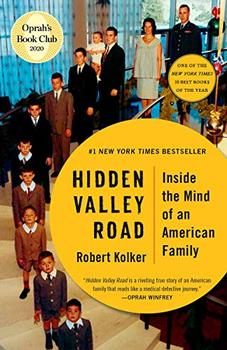Summary | Excerpt | Reading Guide | Reviews | Beyond the Book | Readalikes | Genres & Themes | Author Bio

Inside the Mind of an American Family
by Robert Kolker
As the youngest, Lindsay endured some of the worst of what happened—left in harm's way, directly hurt by people she thought loved her. When she was little, all she wanted was to be someone else. She could have left Colorado and started over, changed her name for real, assumed a new identity, and tried to scribble over the memory of all she went through. A different person would have gotten out as soon as she could and never come back.
And yet here Lindsay is at Point of the Pines, checking to see if the brother she once dreaded needs a heart examination, if he's signed all the forms that need signing, if the doctor has seen him enough. She does the same for her other sick brothers, too, the ones still living. With Donald, for the length of her visit today, Lindsay pays careful attention as he wanders the halls. She worries that he is not taking good enough care of himself. She wants the best for him.
In spite of everything, she loves him. How did that change?
*
The odds of a family like this one existing at all, much less one that remained intact long enough to be discovered, seem impossible to calculate. The precise genetic pattern of schizophrenia has defied detection; its existence announces itself, but fleetingly, like flickering shadows on the wall of a cave. For more than a century, researchers have understood that one of the biggest risk factors for schizophrenia is heritability. The paradox is that schizophrenia does not appear to be passed directly from parent to child. Psychiatrists, neurobiologists, and geneticists all believed that a code for the condition had to be there somewhere, but have never been able to locate it. Then came the Galvins, who, by virtue of the sheer number of cases, offered a greater degree of insight into the illness's genetic process than anyone imagined possible. Certainly no researcher had ever encountered six brothers in one family—full- blooded siblings, with the same two parents in common, the same shared genetic line.
Starting in the 1980s, the Galvin family became the subject of study by researchers on the hunt for a key to understanding schizophrenia. Their genetic material has been analyzed by the University of Colorado Health Sciences Center, the National Institute of Mental Health, and more than one major pharmaceutical company. As with all such test subjects, their participation was always confidential. But now, after nearly four decades of research, the Galvin family's contribution finally can be seen clearly. Samples of their genetic material have formed the cornerstone of research that has helped unlock our understanding of the disease. By analyzing this family's DNA and comparing it with genetic samples from the general population, researchers are on the cusp of making significant advances in treatment, prediction, and even prevention of schizophrenia.
Until recently, the Galvins were completely unaware of how they might be helping others—oblivious to how their situation had, among some researchers, created such a feeling of promise. But what science has learned from them is only one small portion of their story. That story begins with their parents, Mimi and Don, and a life together that took flight with limitless hope and confidence, only to curdle and collapse in tragedy, confusion, and despair.
But the story of the children—of Lindsay, her sister, and her ten brothers—was always about something different. If their childhood was a funhouse- mirror reflection of the American dream, their story is about what comes after that image is shattered.
That story is about children, now grown, investigating the mysteries of their own childhood—reconstituting the fragments of their parents' dream, and shaping it into something new.
It is about rediscovering the humanity in their own brothers, people who most of the world had decided were all but worthless.
It is about, even after the worst has happened in virtually every imaginable way, finding a new way to understand what it means to be a family.
Excerpted from Hidden Valley Road by Robert Kolker. Copyright © 2020 by Robert Kolker. All rights reserved. No part of this excerpt may be reproduced or reprinted without permission in writing from the publisher.
Your guide toexceptional books
BookBrowse seeks out and recommends the best in contemporary fiction and nonfiction—books that not only engage and entertain but also deepen our understanding of ourselves and the world around us.